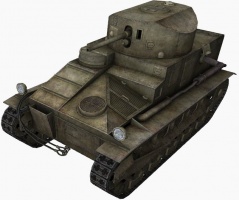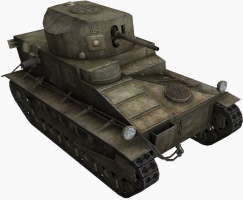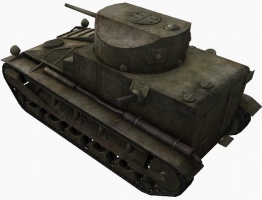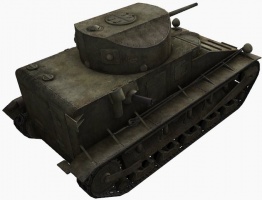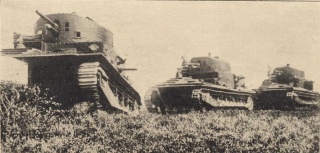Vickers Medium Mk. I
| Revision as of 18:10, 3 November 2012 | Revision as of 03:37, 8 November 2012 | |||
| Line 1: | Line 1: | |||
| {{TankData | {{TankData | |||
| ? | |The Vickers "Medium Mark I" is the only tier 1 medium tank. Unfortunately it does not have many advantages as such. It's slow and large, and its armor is paper-thin. The | + | |The Vickers "Medium Mark I" is the only tier 1 medium tank. Unfortunately it does not have many advantages as such. It's slow and large, and its armor is paper-thin. Although it's a medium tank, it has the least armor of any tier 1 tank. However, having medium status gives the Medium Mark I a higher hitpoint pool than average tanks. The greatest feature of this tank, however, is its end gun, able to take down any tier 1 tank in 2-3 shots, making it a force to be reckoned with. | |
| |Gallery= | |Gallery= | |||
Revision as of 03:37, 8 November 2012
Vickers Medium Mk. I
Mouse over "
[Client Values; Actual values in
| 0 |
| 30060 HP Hit Points |
| 11.79/13.25.1/13.2 t Weight Limit |
- Commander
- Gunner
- Driver
- Radio Operator
- Loader
| 9090 hp Engine Power |
| 24/8 km/h Speed Limit |
| 3535 deg/s Traverse |
| 7.6317.65 hp/t Power/Wt Ratio |
| NoNo Pivot |
| // mm Hull Armor |
| 6.35/6.35/6.356.35/6.35/6.35 mm Turret Armor |
AP/APCR/HE
AP//HE Shells |
0/800/0
35/1200/22 Shell Cost |
| 50/50/6570/70/95 HP Damage |
| 38/66/2345/57/29 mm Penetration |
|
13.33 r/m ▲
13.33 r/m Standard Gun ▲ Rate of Fire Standard Gun |
|
666.5 ▲
Standard Gun
▼
Standard Gun
▲
933.1 Standard Gun ▲
Standard Gun
▼
Standard Gun
▲ Damage Per Minute Standard Gun |
|
0.45 m ▲
0.52 m With 50% Crew: 0.557 m ▲ Accuracy With 50% Crew: 0.644 m |
| 2.9 s 2.3 s Aim time |
| 3232 deg/s Turret Traverse |
| 360° Gun Arc |
| -7°/+16°-7°/+16° Elevation Arc |
| 205140 rounds Ammo Capacity |
| 2020 % Chance of Fire |
| 280 m 280 m View Range |
| 250 m 250 m Signal Range |
I
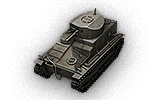
0
The Vickers Medium Mk. I is a British tier 1 medium tank.
In 1921, Vickers-Armstrong developed a project for the Vickers Light Tank. The 1923–1924 trials showed that the tank was ready for mass production. In 1924, the vehicle was renamed the Vickers Medium Tank Mk. I. The same year, a total of 30 vehicles were produced and entered service. Another 50 vehicles of the Mk. IA modification were manufactured later. The Vickers Medium Tank remained in service until 1938.
The Vickers "Medium Mark I" is the only tier 1 medium tank. Unfortunately it does not have many advantages as such. It's slow and large, and its armor is paper-thin. Although it's a medium tank, it has the least armor of any tier 1 tank. However, having medium status gives the Medium Mark I a higher hitpoint pool than average tanks. The greatest feature of this tank, however, is its end gun, able to take down any tier 1 tank in 2-3 shots, making it a force to be reckoned with.
The Vickers Medium Mk. I marks the end of its British medium line.
Modules / Available Equipment and Consumables
Modules
| Tier | Engine | Engine Power (hp) |
Chance of Fire on Impact (%) |
Weight (kg) |
Price (
| |
|---|---|---|---|---|---|---|
| I | Armstrong Siddeley V8 | 90 | 20 | 200 | 0 |
| Tier | Suspension | Load Limit (т) |
Traverse Speed (gr/sec) |
Rmin | Weight (kg) |
Price (
| |
|---|---|---|---|---|---|---|---|
| I | Vickers Medium Mk. IA* | 13.2 | 35 | B/2 | 3000 | 0 |
Compatible Equipment
Compatible Consumables
Player Opinion
Pros and Cons
Pros:
- The 57mm gun is powerful. You can destroy a tier 1 tank with 2 shots.
- Large crew complement reduces extent of tank performance loss when crew are injured.
- Highest hit points of any tier 1 tank.
- The stock gun is the most accurate of any tier 1 tank. Germany and USSR come second.
Cons:
- Large silhouette
- Worthless armor. Every weapon can penetrate it.
- Moves like a brick, so it can easily be circled by other tanks.
- Top gun accuracy is poor.
Performance
Ironically, despite being the only tier 1 medium tank, the Medium Mark I has the worst armor. Designed as an infantry tank, it was armored only to stop small arms fire. It is no match for even the weakest weapons in World of Tanks. Due to the large size of this tank it is easy to hit, so try to take cover behind rocks and bushes etc. The tank is slow for a tier 1 so try to advance behind your team. The 57mm gun is very powerful and is only the real advantage this tank has. Overall it is best to quickly move on to tier 2.
The Machine Gun BESA is devastating against opposing Medium Mark Is and Medium Mark IIs. Like the French 13.2 mm Hotchkiss mle., it fires bursts of five rounds, but it has higher damage and penetration. It remains effective against all tier 1 tanks and some tier 2 tanks, but comes up short against more heavily armored tier 2 tanks. It has a large magazine size of 40 rounds, but the reload time is 24+ seconds (even longer with a 50% crew), so be sure to reload between engagements. Often once your magazine runs out, you will die, unless there aren't any more opponents nearby. Historical Note: The BESA fires 7.92 x 57mm Mauser rounds.
Early Research
- The turret and top gun require upgrading the suspension, but the engine and radio can be fitted without them.
- It's important to note that most, if not all, British tanks use the same radio. It's advised that you don't sell your radios.
Suggested Equipment
Gallery
Historical Info
After the First World War Britain disbanded most of its tank units: their number was limited to five tank battalions, equipped with the Mark V and the Medium Mark C. A large budget was at first made available for tank design; this was however all spent on the failed development of the Medium Mark D. When in 1923 the government design bureau, the Tank Design Department, was closed, for the time being any direct official involvement in tank development was terminated. But private enterprise had already taken over the torch. Vickers-Armstrong had built two prototypes of a new tank in 1921.
Vickers Light Tank
In 1920 the Infantry had plans to acquire a Light Infantry Tank. Colonel Johnson of the Tank Design Department derived such a type from the Medium Mark D. In competition Vickers built the Vickers Light Tank.
The Vickers design still was reminiscent of the Great War types. It had a high, lozenge-shaped, track frame with side doors but it also showed some improvements. There was a fully revolving turret and the suspension was sprung by vertical helical springs, while the Medium Mark C still had a fixed turret and was unsprung. The Vickers was really a light tank; it was small vehicle, just seven feet high and weighing only 8.5 short tons. It was driven by a separately compartmented 86 hp engine through an advanced hydraulic Williams-Jenney transmission, allowing infinitely variable turn cycles. The first prototype was a "Female" version with three Hotchkiss machine guns; the second prototype was "Male", its turret bristling with armament with the addition of a 3-pounder gun and a machine gun for anti-aircraft use. It had clearly been intended to give the vehicle a modern look: the turret, the front of the fighting compartment and the hull front plate were all strongly rounded. The advanced transmission proved to be utterly unreliable however and the project was abandoned in 1922 in favour of a generally more conventional design: the Vickers Light Tank Mark I, that would be renamed to Vickers Medium Tank Mark I in 1924 . The first prototypes were sent to Bovington for trial in 1923. The Vickers designation was A2E1.
Description
Despite being in general more conventional, in one aspect the Medium Mark I looked rather modern: instead of a high track run it possessed a low and flat suspension system with five bogies, each having a pair of small double wheels. The axles of these were too weakly constructed; as Major-General N.W. Duncan put it in his Medium Marks I-III: "(...) a perpetual nuisance. The axles were continually breaking and the path of the Mark I tanks was littered with discarded wheels". This was cured by switching to a "box bogie" in 1931. To ease repairs the suspension was not protected by an armoured covering. There were two vertical helical springs of unequal length in each of the five bogie casings attached to the hull. In front and behind the normal ten road wheel pairs, there was a tension wheel pair. Ground pressure was very high, even though at 11.7 long tons the vehicle was not very heavy for its size.
The engine was an air-cooled 90 hp Armstrong Siddeley engine derived from an aircraft type. Surprisingly the engine and transmission was distributed throughout the hull - with the engine to the left of the driver, the gearbox underneath the commander and final drive at the rear, which Duncan describes as "an unbelievable retrograde step in view of war-time experience". The Medium Mark B and the Mark VIII had introduced compartmentalisation to reduce the debilitating effects of engine noise and fumes on the crew. However with the Medium Mark I considerations of ease of maintenance had taken precedence.
The engine drove, via a multiple dry-plate clutch, a four-speed gearbox. It had no synchromesh and switching between gears without excessive noise was a challenge to the driver. A propeller shaft connected the gearbox to a bevel box at the end of the tank which divided the power to a separate epicyclic gear for each track. These gears automatically provided extra emergency torsion to the normal first and second gear if the vehicle suddenly slowed down due to an obstacle or soft ground.
The petrol tanks were at the very rear of the hull, so the fuel lines had to run along the whole length of the vehicle, pumping fuel to a secondary tank that fed the engine by gravity. The engine was lubricated and partially cooled by oil; leakage was common and the original four-gallon reservoir had to be replaced by a 13.5 one. The tank could be electrically started, but only if the motor was already warm, so the first start had to be done by hand from the inside of the vehicle. Maximum speed was about 15 mph and the range about 120 miles.
There was a cylindrical bevelled turret on top of the hull that carried a "Quick Firing" (shell and cartridge in one complete round) three-pounder gun (47 mm calibre) and four ball mountings for Hotchkiss machine guns. A novel, unique feature was a three-man turret. This meant that commander was not distracted with performing either the loader's or gunner's tasks and could fully concentrate on maintaining situational awareness. This gave a huge potential combat advantage, but went largely unnoticed at the time. Other manufacturers tanks did not have this capability until the German Panzer III was developed in 1937. The practical importance of this feature is signified by the fact that later into the World War II, most of both sides tanks' designs either quickly switched to the three-man turret, or were abandoned as obsolete.
There was no co-axial machine gun. There was only room to operate one machine gun from the turret; normally one gun was switched between the respective mountings as the guns were removable. The turret machine gunner doubled as main gun loader. In each side of the hull was a Vickers machine gun. There was one gunner to operate these, he also functioned as a mechanic.
The shape of the Mark I Medium hull was very distinctive. The back was a simple armoured box; the front plate was high and perfectly vertical. Between them, from the armoured hood of the driver at the right of the vehicle six armour plates fanned out to the left, making for a complex hull geometry at that side. In all the tank made an ungainly squat impression. The crew of five was only poorly protected by 6.25 mm plating, rivetted to the chassis, barely enough to counter the threat posed by light machine guns. With its many shot traps the vehicle was unable to withstand even anti-tank rifle fire and it had a high profile. The internal lay-out worsened this vulnerability as the petrol tanks were inside the main compartment.
Operational history
The Medium Mark I replaced some of the Mark V heavy tanks; together with its successor, the slightly improved Vickers Medium Mark II, it served in the Royal Tank Regiments, being the first type of the in total 200 tanks to be phased out in 1938.
The Medium Mark I was the first tank to see "mass" production since the last of the ten Char 2C's had been finished in 1921. Indeed, as of the next tank, the Renault NC27, only about thirty were built, the British Mediums represented most of the world tank production during the Twenties. They never fired a shot in anger and their performance in a real battle can only be speculated upon but as the only modern tanks in existence in the decade after the First World War they provided the British with a unique opportunity to test the many new ideas about mechanised warfare using real operational units. The knowledge thus gained would prove invaluable in the Second World War.




